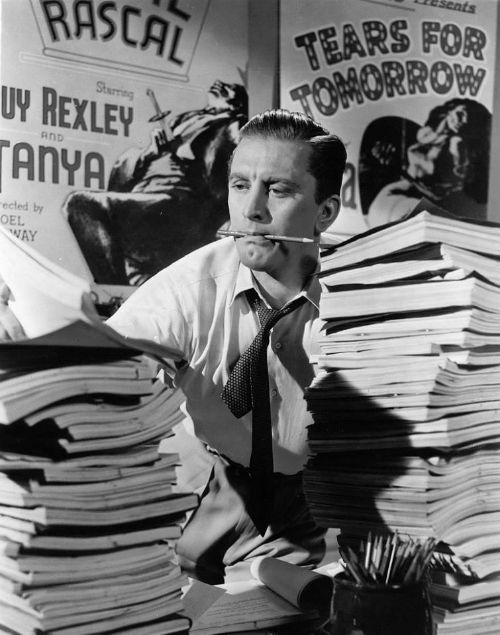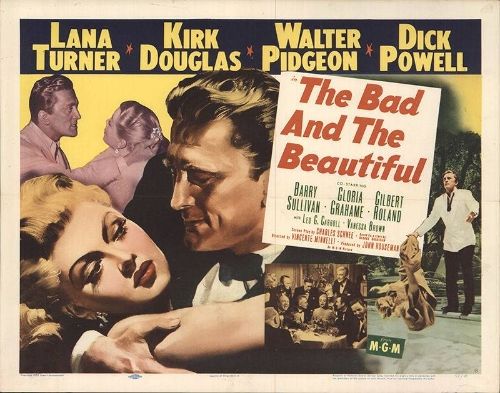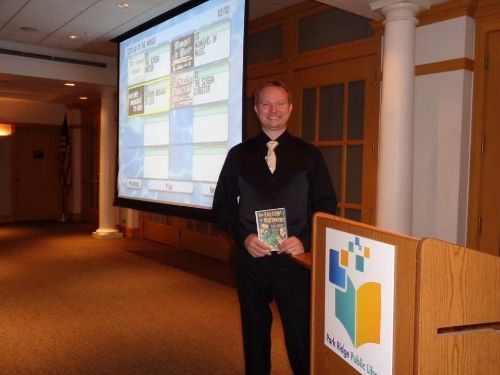“Rich in the details of moviemaking, visually inventive, superbly scripted and acted, The Bad and the Beautiful is a fascinating behind-the-scenes look at the end of Hollywood’s Golden Era. In his analysis of Minnelli’s films, Directed by Vincente Minnelli, Stephen Harvey explains the enduring seductiveness of the film: “The Bad and the Beautiful aspires neither to high art nor newsreel naturalism. By its own example, this black-and-white fantasia celebrates the energy and showmanship that made the studio system flourish.” ~Margarita Landazuri
The following is a transcript of my presentation on The Bad and the Beautiful from May 25, 2017. This was our season finale at the Park Ridge Public Library.
The Bad and the Beautiful (1952) is the story of a Hollywood producer, Jonathan Shields, who uses people for the greater good; in his case, making motion pictures. He turns his surname into a trademark, determined to ram it down everyone’s throat. Motivated by what Hollywood had done to his father, Shields is driven to make great movies in spite of financial limitations—and to make stars out of people the industry had cast aside. His story is told in flashback through three characters who knew him best—three people who benefitted from his knowledge of film despite being hurt by him: Fred, the director who started out with Shields in B pictures; Georgia, the drunken daughter of an acting legend, and James Lee, the novelist encouraged by Shields to become a screenwriter. A long-time studio producer brings these three characters together because Jonathan Shields will need them once again.
Hollywood Bastard: Kirk Douglas as producer Jonathan Shields.

The film is a ripe, ‘50s melodrama that is clearly influenced by the structure of Citizen Kane, a film which told its story through the characters who knew Charles Foster Kane best. The producer on The Bad and the Beautiful, John Houseman, had worked on the screenplay for the Orson Welles film. Another link to Kane is actor Paul Stewart, who in this film plays a press agent. But that’s where the similarities end; though it falls short of Kane’s intricacy, the film offers one of the most fascinating looks into the Hollywood system.
In fact, it is the first major film to focus on the role of the producer. The film takes the moviegoer through all the stages of film production that Jonathan Shields is responsible for. One of the most memorable moments is the “in the dark” scene in the screening room. Here, Jonathan and his partner devise a story pitch to sell a low-budget horror movie. The scene shows both the Shields magic and the art of story collaboration. It would be decades before Hollywood would again make a film that so fully captured the influence of the studio producer.
“Well, right now I don’t need a wife. I need a star.”

Kirk Douglas plays Jonathan with a jaw-thrusting manic energy. At various times in the movie he is both cruel and charming. He imbues this character with an intense, pathological desire to succeed in order to avenge the shortcomings of his father. He’ll even pay studio extras to attend his father’s funeral just so the elder Shields can be with a crowd at the very end. The qualities that make Jonathan a callous human being also make him a great producer. Ultimately, this conflict will lead him to his own lonely place. The role of Jonathan Shields is not based on any specific, real-life figure in Hollywood, although it’s been suggested that the character was inspired in part by producers David O. Selznick and Val Lewton. Additionally, Shields is called the “genius boy,” which is an obvious reference to the “boy genius” of Hollywood, Orson Welles.
Lana Turner was never mistaken for a great actress, but she was one of the most glamorous. She is perhaps best-known for her role in The Postman Always Rings Twice. Like the Georgia Lorrison character she plays in The Bad and the Beautiful, she had the kind of star quality that separated her from most other actors on screen. And sadly, both Lana and her character were alcoholics. With the possible exception of Douglas Sirk’s Imitation of Life, her role in tonight’s film is perhaps the best of her career. Georgia Lorrison displays the same kind of insecurity that Lana Turner had in her own life.
The Bad and the Beautiful also stars Barry Sullivan as director Fred Amiel. Sullivan’s acting career began in 1940 and continued into the 1980s both in film and television. Former Warner Bros. crooner Dick Powell is James Lee Bartlow, the pipe-smoking novelist who stays on in Hollywood as a writer. Gloria Grahame plays his Southern belle wife. Despite her limited screen time of under ten minutes, Grahame somehow managed to win an Academy Award for Best Supporting Actress for her role as Rosemary Bartlow. Also in the cast is Walter Pidgeon as studio producer Harry Pebbel and Gilbert Roland as the Latin seducer, “Gaucho.”
The Oscar-winning story was written by Charles Schnee and based on a 1949 magazine story “Of Good and Evil,” by George Bradshaw. Bradshaw later expanded his story into a longer piece entitled “Memorial to a Bad Man.” The film was directed by Chicago-born Vincente Minnelli. He is best remembered for the musicals he made including Meet Me in St. Louis starring Judy Garland (whom he would marry), The Band Wagon, An American in Paris, and Gigi, for which he won an Oscar. He was also capable of handling great melodramas such as 1958’s Some Came Running. However, based on the “re-creations” seen in The Bad and the Beautiful, Minnelli might’ve had problems doing Westerns and horror films!
Minnelli’s films are noteworthy for their cinematography and a camera that is always moving. One of the most hair-raising moments is a scene in which Georgia leaves the Shields mansion after finding him with another woman. She gets into her car and is in hysterics. She is driving fast, and we feel like we are in that car with her as a passenger, but we never see the road (as we normally would in such scenes). It’s not a static shot with the camera locked in one place. It’s a remarkable piece of filmmaking– and just one small part of a visually great film.
Ten years after The Bad and the Beautiful, Minnelli directed Two Weeks in Another Town, which was another film that dealt with the movie industry. It had the same producer, screenwriter, composer, and star—Kirk Douglas—but it was not a sequel, although clips from the 1952 film do appear in a scene set inside a screening room.
One of the outstanding features of tonight’s film is the musical score by David Raksin. He had gotten his start in 1936 as an arranger for Charlie Chaplin on Modern Times. Raksin scored many classic films and is best-known for his “Laura” theme from the movie of the same name. For the Minnelli film, he wrote a theme called “The Bad and the Beautiful,” which later went on to become a hit and a jazz standard. There is also a performance of the song “Don’t Blame Me,” which would be sung yet again in Two Weeks in Another Town.
The Bad and the Beautiful would go on to win five Academy Awards, though it did not receive nominations for Best Picture or Best Director. Kirk Douglas was nominated for Best Actor but lost to Gary Cooper for High Noon. Nevertheless, this was high praise for a film that is a cynical, dark expose of the industry. The Bad and the Beautiful is an insider’s look into film production and finance, but it’s principally a drama about relationships. It aspires to tragedy as it explores the main character’s egotism. It’s Jonathan’s ego that fuels his artistic drive and turns him into an outcast in need of saving.




